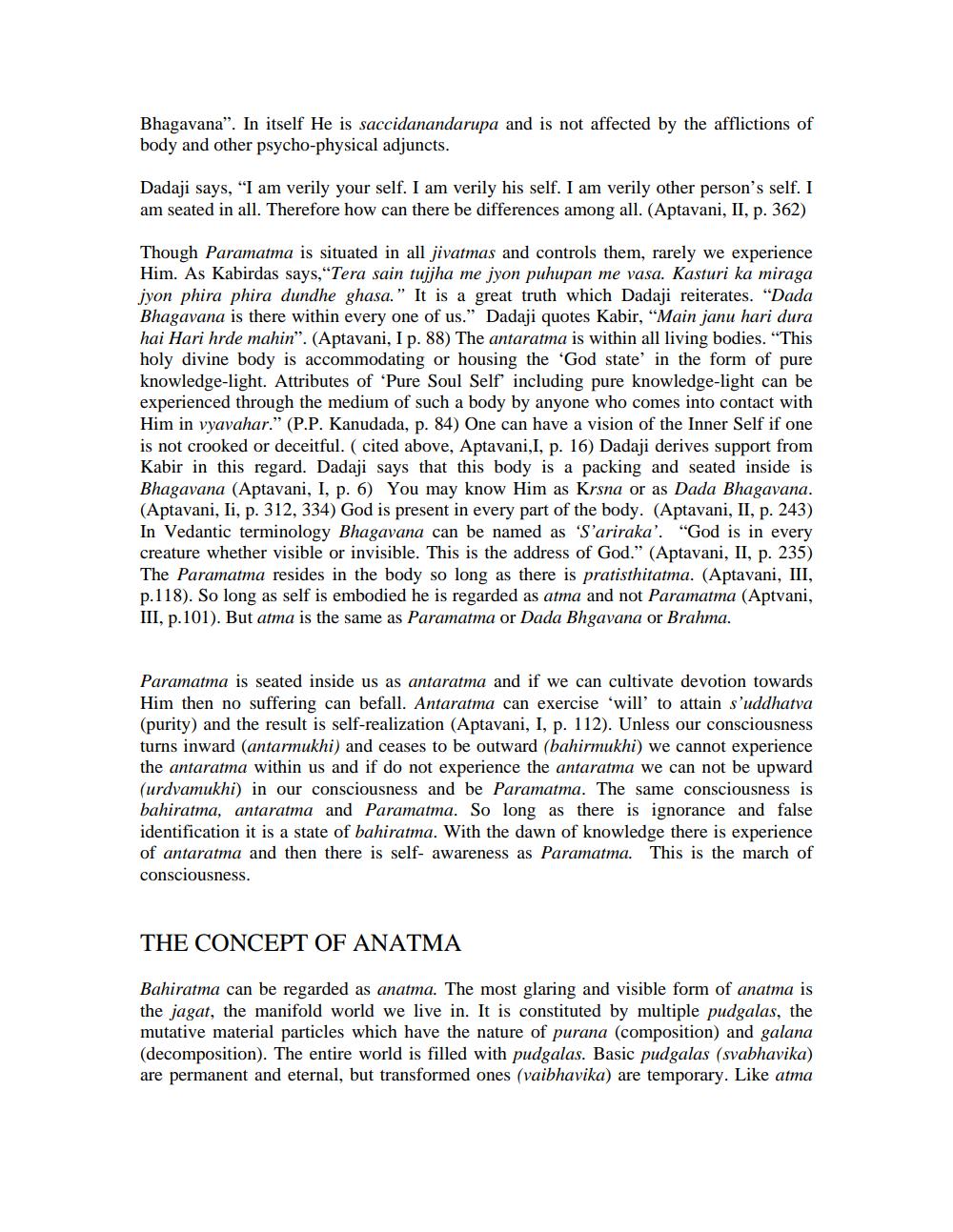________________
Bhagavana". In itself He is saccidanandarupa and is not affected by the afflictions of body and other psycho-physical adjuncts.
Dadaji says, "I am verily your self. I am verily his self. I am verily other person's self. I am seated in all. Therefore how can there be differences among all. (Aptavani, II, p. 362)
Though Paramatma is situated in all jivatmas and controls them, rarely we experience Him. As Kabirdas says, "Tera sain tujjha me jyon puhupan me vasa. Kasturi ka miraga jyon phira phira dundhe ghasa." It is a great truth which Dadaji reiterates. "Dada Bhagavana is there within every one of us." Dadaji quotes Kabir, "Main janu hari dura hai Hari hrde mahin". (Aptavani, I p. 88) The antaratma is within all living bodies. "This holy divine body is accommodating or housing the 'God state in the form of pure knowledge-light. Attributes of 'Pure Soul Self including pure knowledge-light can be experienced through the medium of such a body by anyone who comes into contact with Him in vyavahar." (P.P. Kanudada, p. 84) One can have a vision of the Inner Self if one is not crooked or deceitful. ( cited above, Aptavani,I, p. 16) Dadaji derives support from Kabir in this regard. Dadaji says that this body is a packing and seated inside is Bhagavana (Aptavani, I, p. 6) You may know Him as Krsna or as Dada Bhagavana. (Aptavani, li, p. 312, 334) God is present in every part of the body. (Aptavani, II, p. 243) In Vedantic terminology Bhagavana can be named as 'S'ariraka'. "God is in every creature whether visible or invisible. This is the address of God." (Aptavani, II, p. 235) The Paramatma resides in the body so long as there is pratisthitatma. (Aptavani, III, p.118). So long as self is embodied he is regarded as atma and not Paramatma (Aptvani, III, p.101). But atma is the same as Paramatma or Dada Bhgavana or Brahma.
Paramatma is seated inside us as antaratma and if we can cultivate devotion towards Him then no suffering can befall. Antaratma can exercise 'will' to attain s'uddhatva (purity) and the result is self-realization (Aptavani, I, p. 112). Unless our consciousness turns inward (antarmukhi) and ceases to be outward (bahirmukhi) we cannot experience the antaratma within us and if do not experience the antaratma we can not be upward (urdvamukhi) in our consciousness and be Paramatma. The same consciousness is bahiratma, antaratma and Paramatma. So long as there is ignorance and false identification it is a state of bahiratma. With the dawn of knowledge there is experience of antaratma and then there is self- awareness as Paramatma. This is the march of consciousness.
THE CONCEPT OF ANATMA
Bahiratma can be regarded as anatma. The most glaring and visible form of anatma is the jagat, the manifold world we live in. It is constituted by multiple pudgalas, the mutative material particles which have the nature of purana (composition) and galana (decomposition). The entire world is filled with pudgalas. Basic pudgalas (svabhavika) are permanent and eternal, but transformed ones (vaibhavika) are temporary. Like atma




